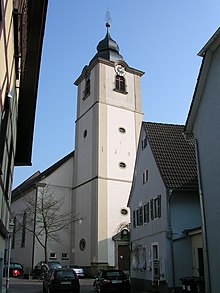Evangelical town church Sinsheim
The Protestant town church in Sinsheim in the Rhein-Neckar-Kreis in Baden-Württemberg goes back to a medieval church, was temporarily in use as a simultaneous church and got its present form around 1800.
history
In addition to the collegiate church on Michaelsberg, the Jakobuskirche was built in the village in the 12th century. In the time of the early Reformation, a Protestant pastor was expelled from Sinsheim in 1527. Around 1540 the reformer Ottmar Stab worked as a pastor in Sinsheim. The Reformation was formally carried out in 1553 with the first local evangelical priest appointed by the Electoral Palatinate , after which the city shared the eventful religious history of the Electoral Palatinate. In 1557 Sinsheim received its first Protestant church order and from 1559 the Reformed Confession prevailed. Between 1576 and 1583 Sinsheim was temporarily Lutheran . During the Thirty Years War Sinsheim was temporarily Catholic.
When the city burned down in the Palatinate War of Succession in 1698, the church was also badly damaged. From 1696 there was a Lutheran congregation again. From 1697 the only remaining ruinous church on site after the abolition of the monastery was used simultaneously by both Protestant and the now officially approved Catholic parish before it was divided as part of the church division of the Palatinate in 1707. The Catholics were allowed the choir, the Reformed the nave, which was still in ruins after the fire of 1698. In 1712 a partition wall was built in, and in 1717 the nave was renewed. After the first structural damage to the nave appeared in 1734, it was closed due to construction defects in 1766 and renewed again until 1782. The catholic part of the church was renewed until 1788, the tower until 1806.
When Lutheran and Reformed congregations were united to form the Protestant regional church of Baden, the united congregations decided to continue using the city church, half of which was still used by the Catholics. The church continued to use both denominations until the Catholic Church of St. James the Elder in 1967 . Ä. was completed.
Bells
Due to the long and eventful history of the church, there are numerous historical bells in the church. The bells taken from the dilapidated tower in 1780 include a large bell that hung in the town hall tower after 1813, as well as the small bell from 1418, which was sold to the church in Eschelbach in 1812 and which is now in the Palatinate Museum in Heidelberg. After the tower was completed in 1806, a new bronze triple bell was procured from Gebr. Barthels in Frankfurt am Main. After the union of Lutherans and Reformed Churches, the two larger bells of the Lutheran church were also placed in the bell tower of the town church in 1832, while a small, previously Lutheran bell went into the town hall tower. Two of the three bells of the Lutheran Church were cast by Lucas Speck in Heidelberg in 1805 . The smallest of the Barthels bells from 1806 burst in 1863 and was cast in 1864 by Georg Hamm in Kaiserslautern.
The three largest bells of the peal had to be delivered for armaments purposes during the First World War . The Hamm bell from 1864 and the small bacon bell from 1805 remained. The latter was replaced in 1923 by a second-hand bell that had been cast by Konrad Scheel in Kolberg in 1725. In addition, in 1923 the ringing was extended by two cast steel bells from the Thorgau steelworks of AG Lauchhammer. During the Second World War , the two old bronze bells then had to be delivered. The remaining steel bells were sold as scrap metal to Hüttenwerke Ulm in 1958 and a new bronze four-bell ring, cast in 1958 by Friedrich Wilhelm Schilling in Heidelberg, was procured. The Christ bell has the percussive c 'kg a diameter of 154.7 cm and a weight of the 2173rd The Marienglocke has the strike tone es', a diameter of 128.4 cm and a weight of 1391 kg. The Joseph Bell has the strike tone f ', a diameter of 115.5 cm and a weight of 1039 kg. The prayer bell has the strike sound as', a diameter of 104.8 cm and weighs 775 kg.
The small baptismal bell from 1441 was not reported in the First World War and was considered to be absolutely worth preserving in the Second World War, so that it survived both World Wars. It has the striking note of the '', a diameter of 39 cm and a weight of 47 kg. Their inscription reads ihesus + maria + ano + m + cccc + xli .
Individual evidence
- ↑ a b Jung 2009, pp. 57-68.
- ^ Bertold Hergenröter: Church division in other important cities of the Electoral Palatinate . In: Mosbacher Jahresheft 18, Mosbach 2008, p. 59/60 (Keyser in Badisches Städtebuch erroneously mentions 1715).
- ^ Bertold Hergenröter: Church division in other important cities of the Electoral Palatinate . In: Mosbacher Jahresheft 18, Mosbach 2008, pp. 59/60.
- ↑ Karl Wilhelmi: History of the Grand Ducal-Badische Amtsstadt Sinsheim , Sinsheim 1856, p. 189, there erroneously mentioned sale to Eschelbronn, correction by Jung 2009, p. 60.
- ↑ a b c Jung 2009, pp. 58–67.
- ↑ The years of casting 1449 or 1450 are also mentioned differently for this bell, corrected by Jung 2009, p. 59/60 u. 67.
literature
- Norbert Jung: ihesvs maria + ano + m + cccc + xli - A contribution to the history of bells in the city of Sinsheim , Heilbronn 2009, pp. 58–67.
Coordinates: 49 ° 15 '9.8 " N , 8 ° 52' 32.9" E
